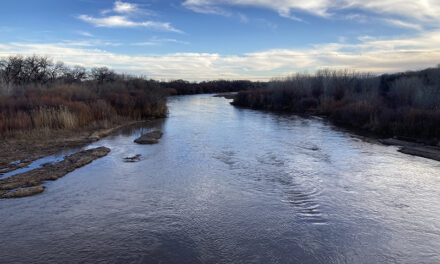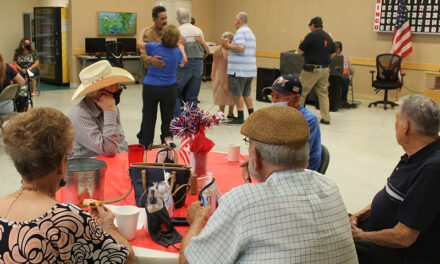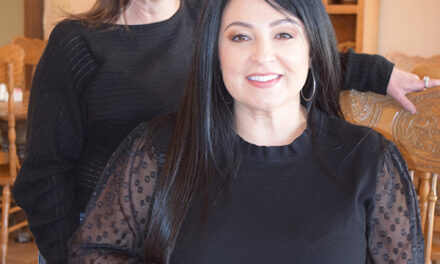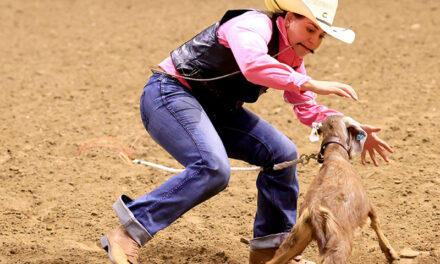While not everyone has the resources to be officially certified in resuscitation, simple measures when someone goes into cardiac arrest can be taken which may be the difference between life and death.
According to the American Heart Association, 475,000 Americans die of heart attacks every year, with 350,000 total incidents occurring outside of a hospital setting.
The AHS says immediate bystander, or hands-only, CPR could double or triple a person’s chances of survival if the cardiac arrest occurs outside of a hospital.
“One thing that is unfortunate is when somebody does go into cardiac arrest, whether in a public place or at home, typically people don’t do anything because they are more scared to intervene,” said Tim Gutierrez, a program coordinator in the Health Sciences Division at the University of New Mexico-Valencia campus.
Ninety percent of cardiac arrests which occur outside of a hospital end in death, with most of the out-of-hospital incidents occurring in their home.
Gutierrez teaches basic life support, or BLS classes, at the university tailored for those entering into the health care field, such as nurses, phlebotomists or EMS. However, he said, people don’t necessarily need to be certified in CPR to intervene when somebody’s heart stops properly working.
“What you are doing when you do CPR is you are doing the heart’s work,” Gutierrez said. “If somebody is in cardiac arrest, the heart isn’t beating regularly — it’s beating irregularly or it’s not beating at all. Basically, what you are doing is getting oxygen and substrate delivered to the vital tissues throughout the body and in the brain as well.”
How to do bystander CPR
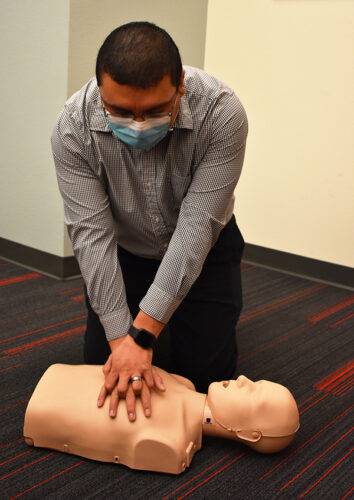
Makayla Grijalva | News-Bulletin photo
Tim Gutierrez, a program coordinator in the Health Sciences Division at The University of New Mexico-Valencia campus, demonstrates on a mannequin how to perform hands-only CPR.
Gutierrez broke down what to do when somebody around you goes into cardiac arrest into two simple steps: first call 911, and then begin doing chest compressions.
“If you do CPR, once you start, you can’t stop — you have to keep doing it,” he said. “That’s why it’s very important to call for help.
“Whether you are CPR certified or not, you always want to call for help because once you get the emergency responders there, you’re going to increase the chance of survival for that person.”
After the first responders are called, chest compressions should commence. To do chest compressions, place your hand in the middle of the person’s chest and overlay your other hand interlocking the fingers while keeping the bottom hand open.
For the average adult, proceed to then press into the chest about 2-inches deep at a rate of 100 to 120 pumps per minute.
Although the popular song to do the correct rate of chest compressions is “Staying Alive” by the Bee Gees, many other songs from a variety of genres also fit the bill, such as “Crazy in Love” by Beyonce featuring Jay-Z, “Hips Don’t Lie” by Shakira and Johnny Cash’s “Walk the Line.”
What not to do
To Squint’s dismay, faking drowning may no longer get him the mouth-to-mouth resuscitation from lifeguard Wendy Peffercorn like he had hoped.
Professionals no longer recommend mouth-to-mouth in helping someone who stopped breathing who you do not know, citing that hands-only CPR is enough to assist in the situation.
“You don’t know if they have any diseases or anything, so you don’t want that transferred over to you,” Gutierrez added.
However, if you do know the person and wish to give them mouth-to-mouth resuscitation, Gutierrez said to completely cover their lips with yours, pinch their nose closed and tip their head back to open the airways.
“The science of CPR has greatly evolved. The American Heart Association has been doing this research for — I think AHA has been around for 100 years — so, they have been doing this research for quite some time.”
Gutierrez also warned not to give anyone experiencing a heart attack any medication not prescribed by a doctor since their condition is generally unknown.
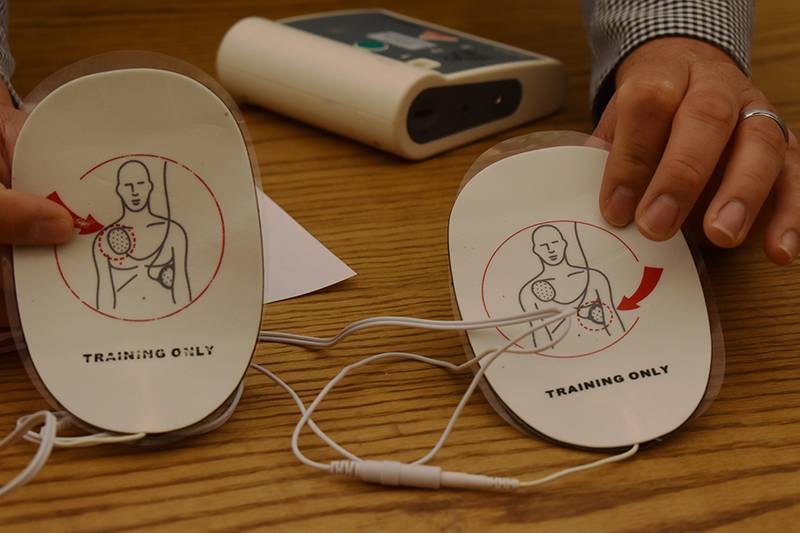
Makayla Grijalva | News-Bulletin photo
Tim Gutierrez said if an AED, automatic external defibrillator, is available, it’s a good idea to use it on someone going into cardiac arrest; however, if the incident happens in the home and a device is not available, chest compressions will still significantly increase their chances of survival. Pictured above are the pads from a practice AED so people can be taught how to set up and connect the device.
Another thing to be aware of is whether the person has a DNR, or do-not-resuscitate order. Typically, older people who do not have the strength to withstand chest compressions are the ones to have a DNR.
“Their family should be aware of it, and it is usually clearly posted within the home,” Gutierrez said. “If someone does have a DNR, then you shouldn’t perform CPR on that person. Unfortunately, if somebody is older, you can do damage to that person, such as breaking their ribs.”
While even for younger people, broken ribs are a risk of hand-only CPR, they are more likely with older folks and to have more severe impacts, he said.
Becoming trained and certified
Gutierrez said at the Valencia campus, they offer courses in BLS, basic life saving, which includes CPR certification tailored for those going into health care fields. They also work with businesses to offer heart-saver classes for their employees with pricing determined on a case-by-case basis.
To practice bystander, or hands-only, CPR, Los Lunas Fire Chief John Gabaldon said local fire departments are again planning on contracting with Project Heartstart in June. Through the program, county residents can practice administering hands-only CPR to mannequins, which offer feedback to the quality-of-life saving measure.
Gutierrez said the most common mistake is typically not doing the chest compressions deep enough or at the correct rate, so the mannequins can help people get a feel for the correct way to do it.
The dates when Project Heartstart is coming to the county have not yet been determined.
Makayla Grijalva was born and raised in Las Cruces. She is a 2020 graduate of The University of New Mexico, where she studied multimedia journalism, political science and history.

